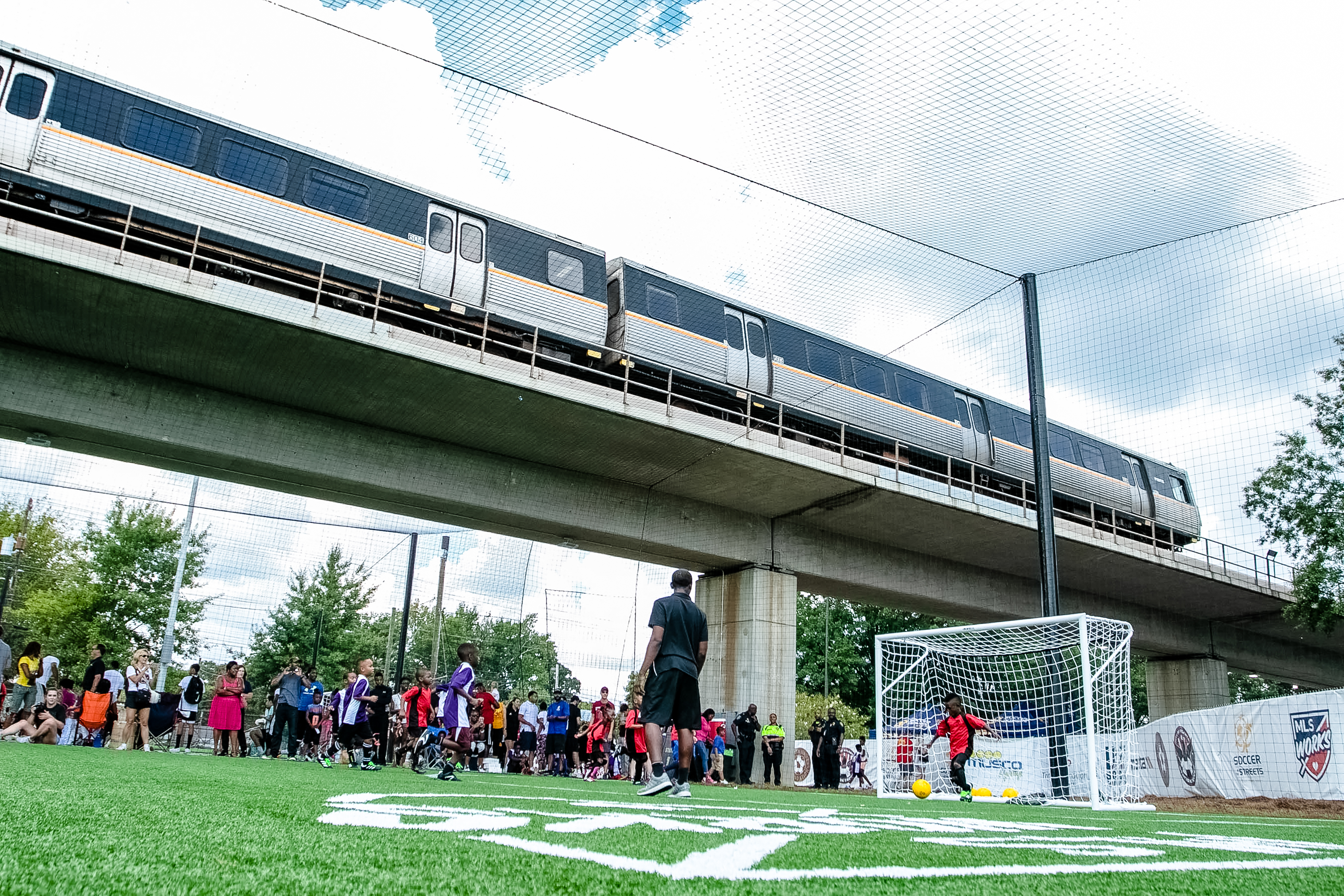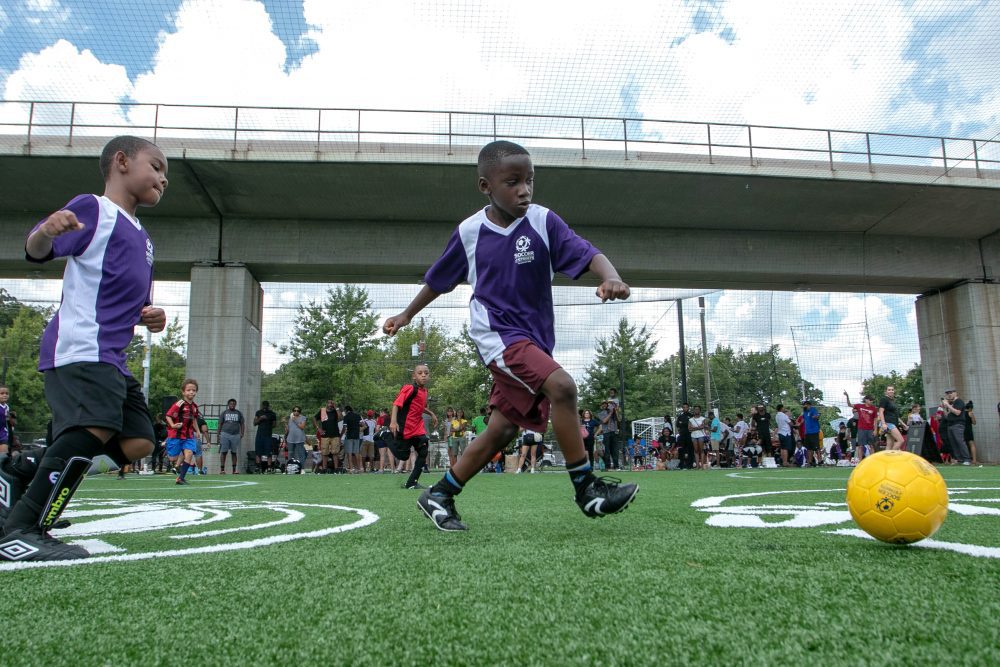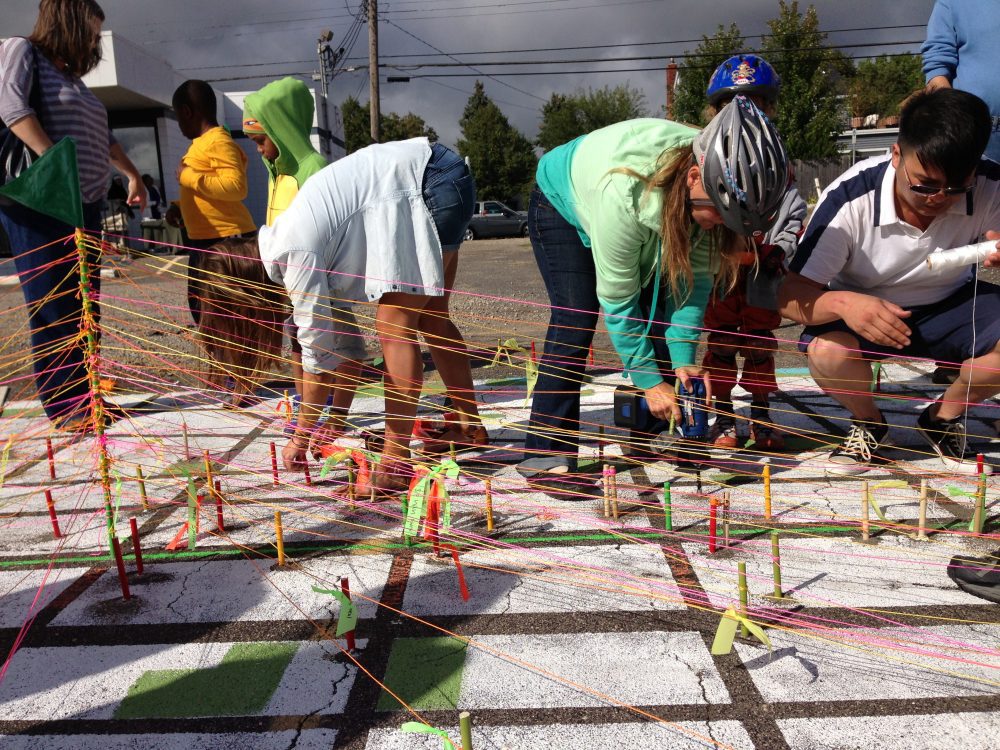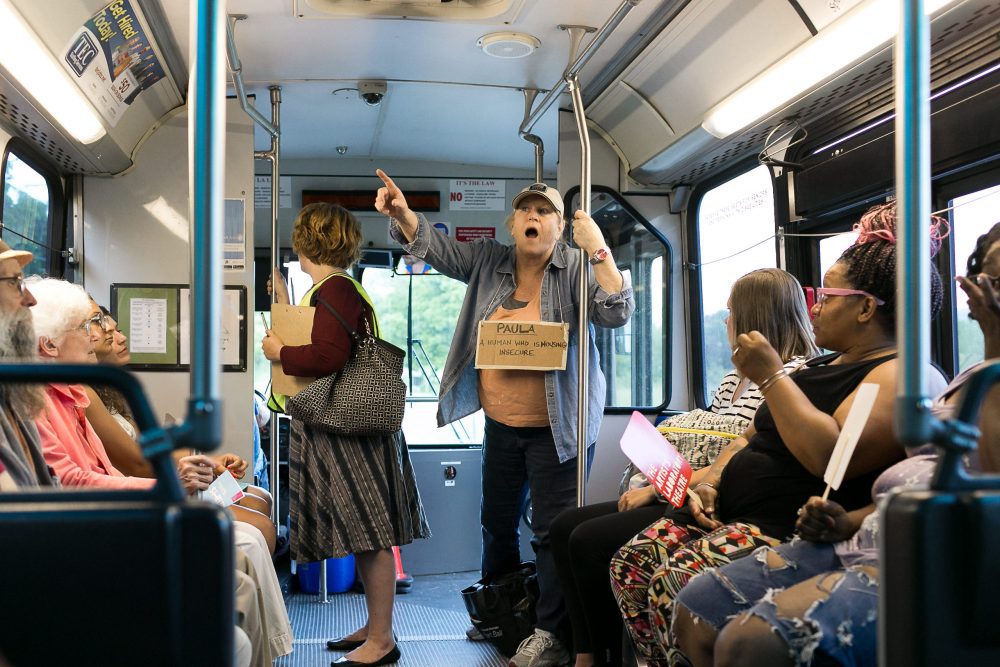
A youth soccer game played at the opening of StationSoccer-West End. Photo courtesy of Dave Williamson
Play is widely accepted as a key component of youth development. But for many young people around the nation, the ability to play an organized sport, or simply play, is contingent on physical and financial access. For children living in lower-income neighborhoods or from lower-income families, that can mean longer walks to the nearest playground or field, as well as the prohibitive cost of team registration fees, lessons, gear, and travel to and from fields, rinks, or gyms. For the last 30 years, Atlanta nonprofit Soccer in the Streets has been removing the cost barrier to soccer by offering free programs and uniforms. Two years ago, it increased access to the sport by constructing soccer fields on unused land owned by the city’s transit authority. Shelterforce’s Keli Tianga spoke with Sanjay Patel, director of Special Projects at Soccer in the Streets, about his innovative idea and the organization’s goals for the future.
Keli A. Tianga: At what point did you have the idea for StationSoccer?
Sanjay Patel: Soccer in the Streets, an Atlanta-based organization [that] celebrates its 30th anniversary this year, has been providing life skills on and off the field through soccer programming. I got involved in 2010. [The organization was] working with kids whose two main hurdles in participating in these programs were affordability and transportation. Soccer in the Streets provides free programs, so [it] had a solution for the affordability part of coaching the kids, but [it] never had a solution for the transportation hurdle. [It was] spending a lot of money on things like renting vans and vehicles.
[In] 2013 and into 2014, I was using transit regularly on my daily commute into downtown Atlanta. There’s a train station next to where I live [in] Edgewood/Candler Park, and I noticed there were large unused spaces of land, primarily unused parking lots that were part of the MARTA parking system.
[Around] that same time, I was on a trip to the U.K. visiting my sister, who also happens to live next to a station in southeast London. I noticed there were kids on that train in soccer gear.
The kids were using transit, and they would walk to a nearby field or place to play. And it got me thinking: what if we could actually convert some of these spaces at the [MARTA] station and do mini-field projects where a lot of youth development happens in soccer, and build a league from it, and then have communities play each other? And can we use the transit to get over that transportation hurdle?
What was the timeline from then to the first groundbreaking?
My first contact to MARTA about this was in April 2014. Our first field project opened in October 2016.
How many fields are there now?
We have Five Points Station in downtown Atlanta; West End Station, which is just south of downtown on the west side of Atlanta; and then East Point Station, which opened [Oct.5], and is located near the airport in the south of Atlanta.

A West End United player kicks a ball during the youth match at the StationSoccer-West End opening. Photo courtesy of Dave Williamson
Does Soccer in the Streets own these fields?
It’s a partnership between MARTA and Soccer in the Streets, and we have a license agreement with them for the land.
Logistically, how does it work? Is there a team affiliated with a specific station, and do they play the other stations/teams, like a league?
We’re building something called the league of stations. For example, say I live at West End, and I’m 8 years old. I would play in the U8 organized practices at West End station [and] represent the U8 West End United team, and I would take the train and play the U8 East Point SC team. They will all play each other, home and away, and they will take the transit system in order to play each other from their transportation standpoint. Our goal here is to build out a league with a network of 10 stations by 2022. We’re now going at two a year. After we open East Point, we’ll actually have another one we plan to go into construction at H. E. Holmes Station later at the end of the year.
Does Soccer in the Streets have a special point of contact at MARTA for this?
I mainly work with the transit-oriented development team, [MARTA’s] real-estate side. I also have interactions with their communications and marketing folks.
Atlanta has experienced real economic transformation in the last three decades. There is growing gentrification in Atlanta and its suburbs, and affordability is an issue. How do you make sure that you are reaching the population that you intend to reach?
We were already in communities where a lot of the transit stations are located. We go to places where kids need access to these programs, and we work primarily in low-income communities.
We’ve started in the southwest area, which is impacted the most. Atlanta is one of the most impacted by income inequality. The areas we’re in, median household income [is] $20,000. In West End, for example, we opened that station project a year ago, and just completed our full registration for the new season, and over 300 kids registered.
How do you get the word out about StationSoccer?
We’re a partner of the Atlanta Public School System. Also, Out Front Media, [which] does advertising for MARTA, heard about our program and gave us free advertising on MARTA platforms. And MARTA has us on their pre-recorded announcements on the train. When you get to West End, the recorded announcement says, “Welcome to West End. Exit here for StationSoccer.” MARTA also has directional signage in the station for our program.
Are there other partners?
Last year, Aetna had a national RFP around health grants for innovative work. And in our sharing our story with them, they were really interested in learning more about this work. Not only did they help provide funding for transit passes for kids in the West End, [but] through their grant, we were able to hire the first community manager full time for the West End station. And it’s a person who’s [from] that community.
One of the big things we’re doing is hiring from within the communities where we do these projects. It builds trust with the parents. Coach Joel, who runs the West End program and lives there, is now taking kids on excursions to local soccer games, like Atlanta United. (Atlanta United gives us tickets to their matches.) The parents trust [Coach Joel], so they allow their kids to go on the train with him.
Atlanta United, one of our biggest partners, was a public/private/nonprofit community-driven project in that they were early believers. When they heard the vision and the idea, they [became] a founding partner. MARTA and the city of Atlanta [were] early partners too. And then, we had groups like TransFormation Alliance, which is a cohort of nonprofits [whose] mission is to work around transit projects in low-income communities. Through something called the SPARCC grant, they came in as partners, and they keep us [intentionally thinking] about community and looking from a racial and social equity lens to help us build social capital.
It’s very much a collaborative kind of alliance.
Are there community health initiatives on the horizon?
From a health standpoint, we’ve got things like the community gardens coming in, and a learning center [in 2020]. We’re using West End as a pilot for how the community can be a big part of building those.
In Atlanta, and many other suburban areas, soccer is a middle-class, upper middle-class white sport that requires a couple of different things in order to play, even though it’s ironic that, in other parts of the world, it’s the opposite.
America, in general, took this sport—globally is known as “the beautiful game” because anyone can play it—and turned it into a pay-to-play system. And it’s quickly become this white middle-class sport, like lacrosse, for example, but you really don’t need any equipment. You could play soccer anywhere. If you travel around the world, you’ll find people playing on beaches, small patches of grass, empty lots [and] empty parking lots. It’s sad because when you really drill down to cities across this country, communities are dying for after-school programs for kids to have things to do, [but] they don’t have access because you have to have money to be able to play, and you have to have transportation.
Are most, or all, of your coaches, volunteer?
All of our coaches are paid, and we have over 50 coaches that work across the Soccer in the Streets network.
Are there any other places in the country that are thinking about this?
There’s no transit agency doing this with any local partner anywhere in the country. When we opened Five Points, it was the first soccer field inside a train station in the world. I recently did a tour with eight different cities from around the country whose transit agencies are interested in what we’re doing.
We are lucky that we’ve got folks within the agency [who] support this. It could easily have been someone [who] didn’t understand the power of sport for development.
There’s so many people [who] have ideas, and they’re not able to take them to cities, municipalities, public institutions, [or] transit agencies because, A, they don’t know where to start, and B, they’re already thinking, “Well, they’re never going to work with us on this.” We’re fortunate that we have people at the agency [who] really are in our corner.
When you do this type of work, sometimes you do get the luck. And there’s still much to do. You meet these folks [who for] decades [have] not had access. And when you see that, it just motivates you even more.
Thank you.





Comments